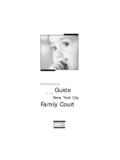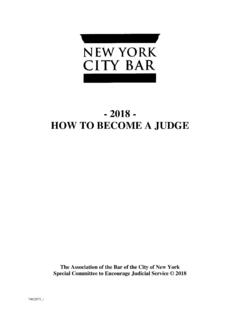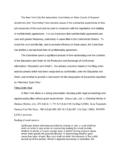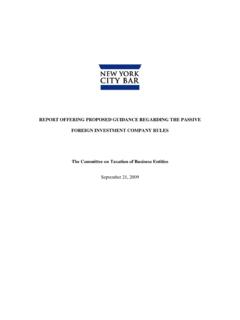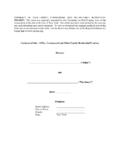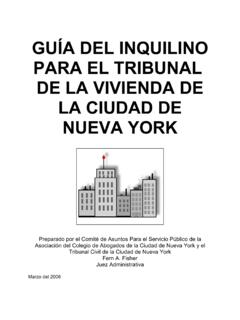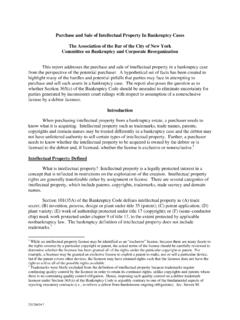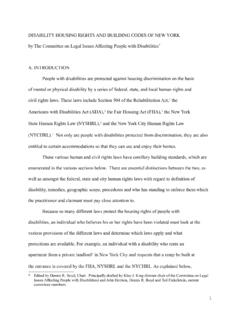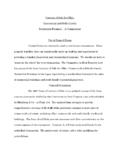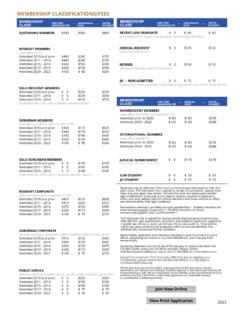Transcription of Report on Engagement Letters of the Professional ...
1 676498v6 Report on Engagement Letters of the Professional Responsibility Committee of the Association of the Bar of the City of New York An Analysis of the Letter of Engagement Rule - Part 1215 to Title 22 of the Official Compilation of Codes, Rules and Regulations of the State of New York (the Rule ) I. Introduction This Report is intended to provide guidance to the Bar on what does and does not constitute compliance with the requirements of the Rule. This Report is not intended to be a comprehensive analysis of the best practices as to what should and should not be included in an Engagement II.
2 The Rule The Rule was proposed and adopted by the New York State Office of Court Administration on March 4, 2002 and amended soon thereafter on April 3, The Rule was designed to limit misunderstandings between attorneys and clients about the scope and cost of legal services;3 it was not, however, designed as a means of disciplining The Subcommittee on Engagement Letters of the Professional Responsibility Committee of the Association of the Bar of the City of New York has drafted this Report with analysis and comment on the Rule. The objective of this Report is to provide guidance to the Bar on: (i) the key elements of the Rule; (ii) how best to comply with the dictates of the Rule; and (iii) factors that can lead to non-compliance with the Rule and an inability to collect fees.
3 III. Purpose of the Rule The Rule was adopted as a court rule rather than as a Disciplinary Rule, and enforcement of the Rule through the disciplinary system was not envisioned by the Contrasting the disciplinary purpose of the rules governing matrimonial matters, 1 See Association of the Bar of the City of New York Formal Opinion 2006-1 regarding advance conflict waivers. 2 COMP. CODES R. & REGS. tit. 22, , (2002). 3 The Craco Committee Report identified misunderstandings over the scope and cost of legal services as one of the greatest sources of public dissatisfaction with lawyers.
4 Roy Simon, SIMON S NEW YORK CODE OF Professional RESPONSIBILITY ANNOTATED 1560 (2007). 4 Chief Administrative Judge Jonathan Lippman said .. this is not about attorney discipline in any way, shape or form, and we certainly do not expect in any significant degree there to be a large number of disciplinary matters coming out of this rule. John Caher, Rule Requires Clients Receive Written Letters of Engagement , 227 1 (2002). 5 Roy Simon, SIMON S NEW YORK CODE OF Professional RESPONSIBILITY ANNOTATED 1562-1563 (2007). 676498v6 2the Second Department in Seth Rubenstein, v.
5 Ganea, 833 566, 2007 WL 1016998 (2d Dep't 2007), noted that [the Rule] contains no penalty language in the event of an attorney's noncompliance, and it is not underscored by a specific Disciplinary Rule, unlike 22 NYCRR and Code of Professional Responsibility DR 2-106(C)(2)(b). If the Appellate for [the Rule] to serve a penal or disciplinary purpose, language could have been included to accomplish that purpose. The Appellate Divisions did not do so. We decline to extend [the Rule] beyond its expressed terms. Seth Rubenstein, 2007 WL 1016998 at 6.
6 IV. The Elements of the Rule A. The Letter 1. When a client brings a matter to an attorney and seeks representation, the client may not be sure what the next step is. Letters of Engagement and retainer agreements ( Letter(s) ) help outline the terms under which the attorney will represent the client, and offer the client a better understanding of the attorney s path of representation. A retainer agreement is a letter of Engagement that has been countersigned by the B. The Rule Explained 1. The Rule, which is attached hereto as Exhibit A, requires that a written Letter be provided to the client prior to commencement of representation when an attorney undertakes to represent a client and enters into an arrangement for, charges or collects any fee from the If doing so is impracticable or the scope of the Engagement cannot be determined at that time, then the Letter should be provided within a reasonable time after commencement of the Engagement .
7 2. The Rule goes on to classify certain entities, including insurance carrier entities, as the client when such entities engage the attorney to represent third parties. This is important to understand, especially in those situations where it s advisable to recognize that both the insurer [and other third-party] and insured [or other type of client] come within the definition of client. 8 If someone other than the client will pay the lawyer's fee bills, DR 5-107(A)(1) 6 David G. Keyko, Practicing Ethics: Engagement Letters , 234 16 (2005).
8 7 In New York, written Engagement Letters are also required in contingency fee matters (governed by DR 2-106(D)) and in domestic relations matters (governed by 22 NYCRR and DR 2-106(C)(2)(b)). 8 Roy Simon, Letter of Engagement and the Defense Bar, THE NEW YORK Professional RESPONSIBILITY Report (New York, ), May 2002, at 2. 676498v6 3requires the client's consent before the lawyer can accept such compensation. 3. When there is a significant change in the scope of services or the fees to be charged to the client, the attorney is required to provide an updated Letter that addresses those changes.
9 C. What the Letter Must Contain 1. The Letter must explain the scope of the legal services to be provided, as well as an explanation of fees, expenses and billing practices. Finally, the Letter must provide notice of the right to arbitrate fee disputes (where applicable). DR 2-106(E) requires fee disputes in civil representations to be resolved by arbitration at the client's election pursuant to Part 137 of the Rules of the Chief Administrator of the New York State Supreme Court, Appellate Division. These rules permit arbitration where the amount of disputed fees range from $1,000 to $50,000.
10 The required disclosure regarding the state-sponsored fee arbitration program is not to be in lieu of including in the Letter any agreed-upon arbitration provision which applies to all disputes that might arise between the client and the lawyer and specifying in such provision the applicable rules and location of the arbitration D. The Retainer Agreement 1. As noted above, a retainer agreement is a letter of Engagement countersigned by both the attorney and the client, and contains all the elements that Letters of Engagement must contain. E. Exceptions 1.
